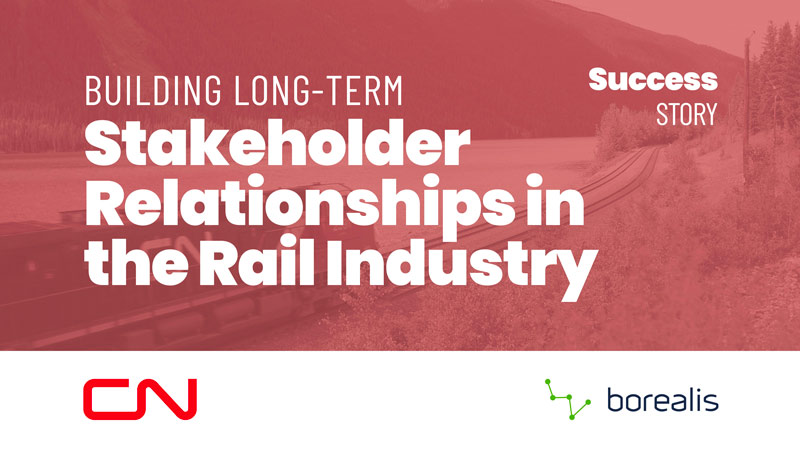Everyone’s talking about stakeholder engagement these days. For good reason: it’s vital to gaining and maintaining access to valuable business resources. Consider Facebook’s recent $7 billion share-price drop. When the social media platform failed to adequately address stakeholders concerns over criticism that it wasn’t sufficiently policing hate speech and disinformation, a number of global brands pulled their paid Facebook ads – including Unilever, Hershey and Coca-Cola.
In our age of polarized confrontation, things like corporate social responsibility, social license and public engagement are essential to the social and economic success of companies – and to their individual projects.
Speaking of projects… If I were to ask you how many projects your business has on the go, would you be able to tell me – at the drop of a hat – who your key stakeholders are and whether they support your project? More specifically, would you be able to qualify your interactions with these stakeholders and the topics discussed with them? Could you pinpoint the specific issues that have emerged from these interactions? Do you even know if you are engaging for the right reasons?
Because you should. Particularly if your projects present significant impacts or opportunities for your stakeholders.
Why CRM customizations fail at stakeholder engagement
In previous articles, we’ve looked at some of the reasons why CRM and SE systems are not interchangeable. That being said, it can be very tempting for IT teams to try to tweak their existing CRM system to integrate stakeholder management.
There are a couple of main reasons why a company might consider going this route. Firstly, the relatively widespread implementation of CRM systems means that these systems are already part of the existing application portfolio of many organizations and therefore may be seen as a possible short-cut. Secondly, the data tracking functionalities of CRM and SE systems are somewhat similar.
Unfortunately, this tweaking exercise is all but doomed to fail from the start – for a number of reasons.
1. CRM implementation has a high risk of failure.
CRM systems are reported to have more than a 50% risk of failure. If a CRM can’t succeed in its own backyard, how can it possibly cope with – let alone excel in – the increasingly complex world of stakeholder management?
2. CRM systems are not built with stakeholder management in mind.
CRM systems are designed for streamlining the key aspects of customer interactions, not for visualizing project infrastructure and identifying key stakeholders. Asking a CRM to do so will only increase the risk of engagement activities not being properly targeted and social risks not being adequately managed. These inefficiencies will in turn increase community engagement costs.
Remember that while most customers will be stakeholders to varying degrees, not all stakeholders will be customers. That means they will have very different needs and interests. Including stakeholder engagement (which is typically a lower priority than sales) in the CRM only increases the risk of not meeting the expectations of users and management.
3. Configuring CRM for stakeholder management purposes is a long, uphill battle.
The languages, processes, functionalities, analytical tools and dashboards in CRM systems are all designed with customer relationships in mind, not stakeholder management. Because of this, CRM systems are poorly suited to needs of community relations or external affairs agents, and even less so to field activities. With highly developed stakeholder engagement systems already out there, there’s little to gain from trying to reinvent what’s already a nearly-perfected wheel.
4. Customizing a CRM is extremely costly and often unsuccessful.
And then there’s the cost of customizing a CRM to bring it to an acceptable level for stakeholder engagement purposes. For most organizations, this will be vastly prohibitive – not to mention highly frustrating and an unnecessary waste of internal resources that could otherwise go to more productive use. It’s not unusual for organizations to invest one or two years in customization only to reject the final outcome because the tweaked system simply did not meet their needs. (This article succinctly answers the eternal buy-or-build question.)
5. It takes a system solidly built around best practices to optimize processes.
As stakeholder engagement becomes increasingly sophisticated – and pivotal to project success – organizations are realizing that they need much more than simply a basic contact register in which issues raised during meetings and other communications are recorded. They need a system designed to encompass all aspects of engagement activities, such as planning and monitoring engagement activities, minimizing unexpected risks, ensuring compliance, managing grievances and commitments, tracking consultations and maintaining social license to operate.

Driving successful stakeholder engagement from day 1
Consider this case in point. A national railway that manages thousands of kilometers of rail tracks passing through hundreds of towns and villages, found itself rethinking its approach to stakeholder engagement. It has an entire team dedicated to handling the multiple incidents that occur each and every day along these tracks. That’s a colossal infrastructure to oversee, not to mention an enormous number of stakeholders to engage in order to adequately address their concerns and expectations.
Even though the railway was spending a fortune on stakeholder relationships, its efforts were not delivering the desired results. Like many other organizations, it too initially looked at adapting its CRM system, but soon realized that all the coding would be too cost and time prohibitive. It would also require a significant amount of internal training. Rather than trying to find a way to fit its CRM to its needs, the railway shifted its thinking and began looking for a stakeholder engagement management system built from the ground up to optimize their stakeholder relationship.
Among other things, it wanted:
- Better reporting (at different levels, such as project vs. corporate)
- Accurate indicators of community concerns and company perception
- Mapping of all assets (both existing and planned)
- Visually compelling information available in just a few clicks
- Improved internal processes and ability to link engagement with company commitments
- Institutional memory of interactions per project, area, stakeholder, etc.
- Most importantly, a stronger engagement strategy
A stakeholder relationship management system offered all this and much more, right out of the box. Deployment was quick and seamless, and training only took a few days.
The right tool means better results
If there’s a moral to this story, it’s that stakeholder management has become a highly specialized field requiring specialized tools. And these tools have evolved greatly in recent years, with the integration of public participation tools, online engagement, social media, big data, etc. The better SE systems out there offer flexible configuration options that can be integrated into your environment with minimal effort, enabling you to efficiently support your existing strategy and processes (offering the ideal solution to the buy-or-build dilemma).
One of the biggest mistakes organizations can make is failing to recognize all key stakeholders and cultivate productive relationships with them. In a future article, we’ll look at how SE software can help you optimize analytics and KPI tracking in order to gain a better picture of how well you’re succeeding at your engagement activities.





